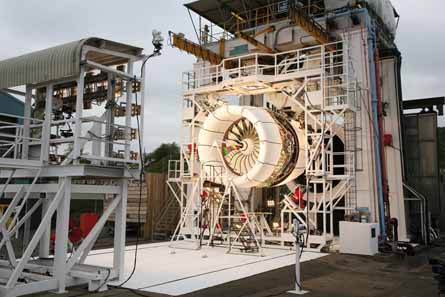Boeing 787's first powerplant set to begin airborne trials on modified 747 this month
Rolls-Royce's Trent 1000 turbofan for the Boeing 787 has successfully passed the crucial blade-off test milestone on its way to the first flight aboard the company's newly commissioned 747 flying testbed, possibly around mid-May.
"We've now got nine engines in the development loop, some of which are already into their second or even third rebuild," says R-R Boeing programmes director Dominic Horwood. Other key milestones passed or in the final phases include the engine type test, the 1,000-cycle initial maintenance interval and bird ingestion tests. Total test hours and cycles exceed 1,000 and 2,000 respectively.
"We completed the fan blade-off test in the middle of April and we're very pleased with the results," says Horwood, who adds that the tests to engine No 7 showed no signs of hydraulic leakage, fire or containment failure. The blade-off test is the most severe of all the certification tests, and is based on explosively releasing a fan blade while the engine is operating at "red line" speeds at full thrust.
| Where are the engines? Forthcoming tests include the "imminent" water-ingestion certification test, undertaken using Trent 1000 engine No 1, which was used primarily for low-pressure system evaluation. Engine No 2, used originally for intermediate pressure system work, is now being used for operability test work. Test engine No 3, a high-pressure system test engine to start with, has now completed all-bird ingestion work, while No 4 has been used to complete a range of altitude testing at the Arnold Engineering Development Center in Tennessee. Engine No 5 is being used for the 150h type test, which Rolls-Royce says it is "driving hard" to complete next month. |
|---|
"We are doing the flight tests with an engine that is the same build standard as the engines that will be used for first flight on the 787 itself," says Horwood, who adds that engine No 6 has now been returned to the UK.
Although the first flight on the 747 was originally set for around February, Horwood says R-R elected to complete the majority of engine altitude testing at the Arnold Engineering Development Center (AEDC) in Tennessee "where we have a very good controlled environment. It's a development programme and for that you have to make sure of the best use for the assets you have.
"We wanted to complete our work at the altitude test facility, which allowed us to get through the AEDC phase, and we have chosen to make sure we're flying on the testbed with a build-standard as close as possible to the actual flight test standard." The current plan calls for the completion of flying testbed work ahead of the start of 787 flight tests, provisionally set to start at the end of August.
The later start to the testbed work does not, therefore, indicate any potential delays to the Trent 1000 development programme, which Horwood says is on track for delivery of the initial engines to Everett for the 787 flight-test programme in June. Ten engines (eight plus two spares) will be involved in flight tests at Boeing. Production engines are due to begin deliveries to Everett in the first quarter of 2008.
n The US Federal Aviation Administration is proposing to levy nine special certification requirements on the 787 to address potential concerns with lithium ion batteries. The aircraft will feature the first commercial use of the new battery technology other than for emergency lighting purposes.
|
|---|
| Trent 1000 engine No 7 completed the fan blade-off test in mid-April |
Source: Flight International
























